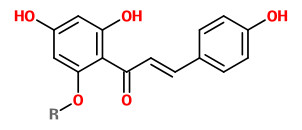Helichrysum arenarium (L.) Moench - syn.Gnaphalium arenarium L. - Asteraceae
yellow everlasting, dwarf everlast, Sand-Strohblume, Gelbes Katzenpfötchen, Ruhrkraut
Perennial herb, entire plant tomentose-lanate, native to Europe, Sibiria, West and Central Asia.
http://www.efloras.org/florataxon.aspx?flora_id=2&taxon_id=200024007
Isosalipurposide (2',4,4',6'-tetrahydroxychalkon-6'-O-glucoside) is mainly responsible for the yellow colour of the flowers.
„The biologically important components of Helichrysum arenarium (L.) Moench are the flavonoids, which may have choleretic, hepatoprotective and antimicrobial properties. During our study, we examined the flavonoids present in the lyophilizate of the inflorescence of Helichrysum arenarium (L.) Moench (Helichrysi flos, syn.Stoechados flos) and in the tea made from the inflorescence via qualitative and quantitative analysis, and determined the flavonoid content. We examined the properties of the lyophilizate antioxidant, and measured the H-donor activity, reducing power property and total scavenger capacity via spectrophotometric and chemiluminescent methods. We compared the results with those of the agent present in milk thistle (Silybum marianum L.), the silibinin flavonoid. Regarding the H-donor activity, our lyophilizate was determined to be more effective than the silibinin at the same amounts; on the other hand, its reducing power property and total scavenger capacity was lower than that of silibinin. The flavonoid content, which is responsible for the lyophilizate effect, was found to be 0.47% according to our measurements; it is, therefore, possible that an extract with such a concentration of flavonoids may be of therapeutic benefit.“
[Biologically active compounds ofHelichrysum arenarium (L.) Moench., Czinner, E., Kery, A., Hagymasi, K., Blazovics, A., Lugasi, A., Szoke, E., Lemberkovics, E., European journal of drug metabolism and pharmacokinetics, Vol.24(4), 1999, 309-313]
The dried flower heads (Helichrysi flos, Flores Gnaphalii arenari) are used as choleretic and diuretic; also said to promote gastric and pancreatic secretions.
„Helichrysum flowers contain several flavanoids. Isosalipurposdie, a chalcone, is responsible for the yellow colour of the bracts. It occurs with the bitter tastiing naringenin, naringenin-5-O-diglucoside (salipurposide), helichrysin A and helichrysin B, and various glycosides of apigenin, luteolin, kaempferol and quercetin.“
[Medicinal Plants of the World. Ben-Erik Van Wyk and Michael Wink, Pretoria 2004, 168]
Main components of essential oil from H.arenarium samples collected in Serbia and Montenegro were limonene (11%), α-ylangene (14%), cyclosativene (11%), di-epi-α-cedrene (17%), α-selinene (8%), and p-cymene (3%).
[Chemical composition and antimicrobial activities of essential oils of Myrrhis odorata (L.) Scop, Hypericum perforatum L and Helichrysum arenarium (L.) Moench., Rančić, A., Soković, M., Vukojević, J., Simić, A., Marin, P., Duletić-Laušević, S., Djoković, D., Journal of Essential Oil Research, Vol.17(3), 2005, 341-345]
Naringenin-7-O-β-d-glycoside, isoquercitrin, and astragalin were also isolated with HSCCC.
[Separation and purification of three flavonoids from Helichrysum arenarium (L.) Moench by HSCCC., Yang, Y., Huang, Y., Gu, D., Yili, A., Sabir, G., Aisa, H.A., Chromatographia, Vol.69(9-10), 2009, 963-967]
„The methanolic extract from the flowers of Helichrysum arenarium L. MOENCH was found to show inhibitory effect on tumor necrosis factor-α (TNF-α, 1 ng/ml)-induced cytotoxicity in L929 cells. From the methanolic extract, 50 constituents including four new flavanone and chalcone glycosides named arenariumosides I, II, III, and IV were isolated. The stereostructures were elucidated on the basis of chemical and physicochemical evidence. Among the constituents, naringenin 7-O-β-D-glucopyranoside, apigenin 7-O-β-D-glucopyranoside, apigenin 7-O-gentiobioside, and apigenin 7,4′-di-O-β-D-glucopyranoside significantly inhibited TNF-α-induced cytotoxicity in L929 cells at 30μM.“
[Medicinal Flowers. XXVII. New Flavanone and Chalcone Glycosides, Arenariumosides I, II, III, and IV, and Tumor Necrosis Factor-. ALPHA. Inhibitors from Everlasting, Flowers of Helichrysum arenarium., Morikawa, T., Wang, L. B., Nakamura, S., Ninomiya, K., Yokoyama, E., Matsuda, H., Yoshikawa, M., Chemical and Pharmaceutical Bulletin, Vol.57(4), 2009, 361-367]
„HPLC analysis was used to develop a method for assay of the isosalipurposide content of dwarf everlast flowers and the medicine “Flamin.” The isosalipurposide content of dwarf everlast flowers varied from 1.56% to 1.78%; the content in “Flamin tablets” ranged from 10.35 to 11.05mg/tablet.“
[Assay of isosalipurposide in raw material and drugs from the dwarf everlast (Helichrysum Arenarium)., Kurkina, A.V., Ryzhov, V.M., Avdeeva, E.V., Pharmaceutical Chemistry Journal, 2012, 1-6]
„Traditional herbal medicinal product used in digestive disorders with a feeling of fullness and bloating… Helichrysi flos is not recommended in case of obstruction of the bile duct, cholangitis, liver disease and gallstones.“
[European Union herbal monograph on Helichrysum arenarium (L.) Moench, flos, Draft EMA/HMPC/41108/2015]
http://www.ema.europa.eu/docs/en_GB/document_library/Herbal_-_Herbal_monograph/2015/10/WC500195685.pdf

Dietrich, A.G., Flora regni borussici, vol. 11: t. 767 (1843) [A.G. Dietrich]
http://plantillustrations.org/species.php?id_species=501336
Helichrysum arenarium
© Rolf Marschner (2009),
www.botanische-spaziergaenge.at
